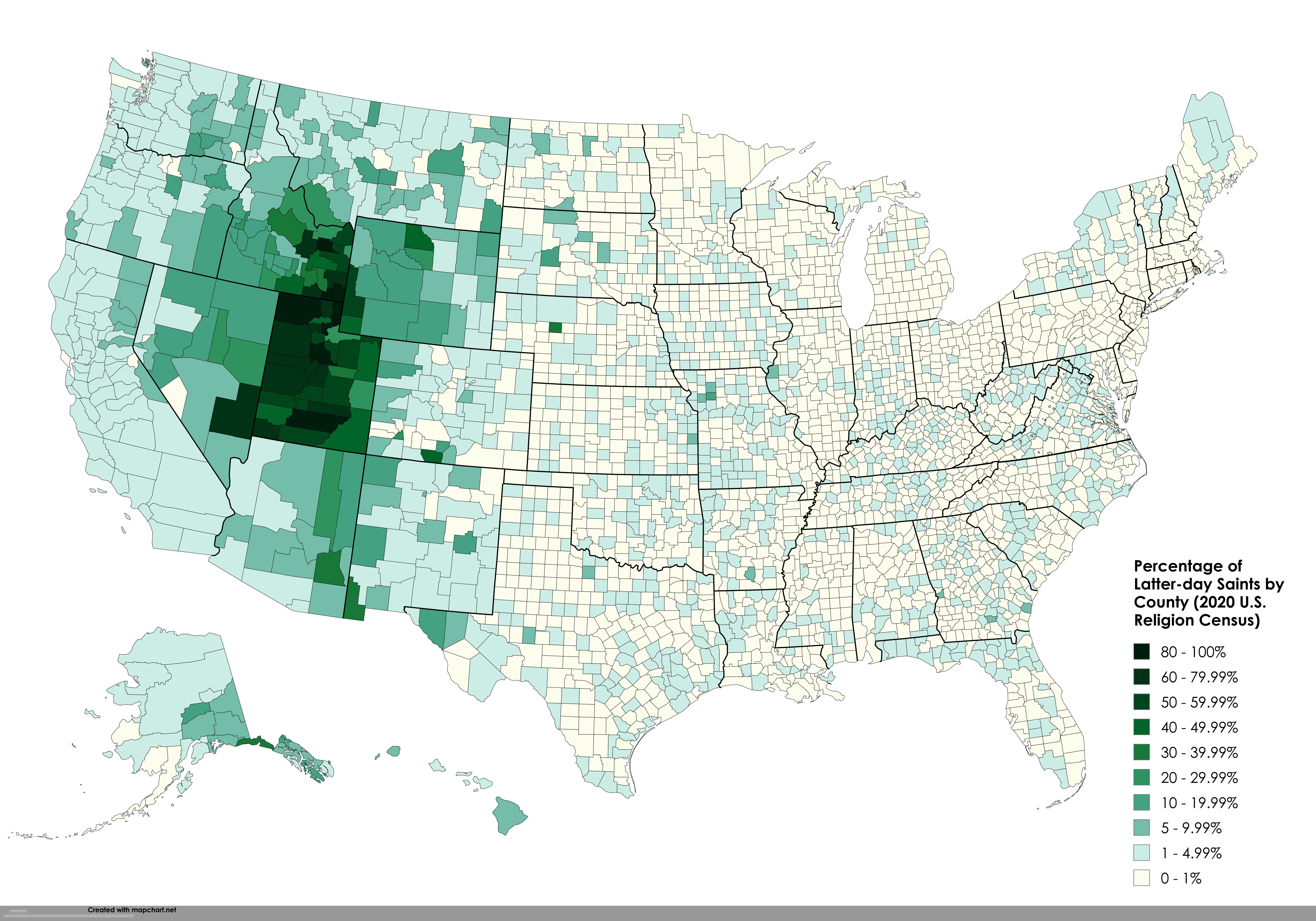Percentage of Latter-day Saints by County Map


David Chen
Data Visualization Specialist
David Chen is an expert in transforming complex geographic datasets into compelling visual narratives. He combines his background in computer science ...
Geographic Analysis
What This Map Shows
This visualization presents the percentage of Latter-day Saints (LDS) residing in each county across the United States, based on data from the 2020 U.S. Religion Census. Unlike previous maps that depicted the overall population of Latter-day Saints, this one provides a clearer understanding of their representation within local communities. By examining the percentage, we can identify areas where the faith is most concentrated, as well as regions with a minimal presence. This nuanced perspective allows for a deeper exploration into the cultural and demographic dynamics of the U.S.
Deep Dive into Latter-day Saints Distribution
The Church of Jesus Christ of Latter-day Saints, often referred to as the LDS Church or Mormon Church, has a unique and fascinating history that shapes its distribution across the United States. Originating in the early 19th century in upstate New York, the church's members faced significant persecution, leading to a westward migration that established a stronghold in Utah. Today, Utah remains the state with the highest percentage of Latter-day Saints, with counties like Salt Lake and Utah County boasting percentages over 50%.
However, the influence of the LDS Church extends beyond Utah. Regions in Idaho, Nevada, and parts of Arizona also showcase significant percentages of Latter-day Saints. For instance, counties such as Bear Lake in Idaho and Clark in Nevada have populations where Latter-day Saints represent over 30% of the total residents. This concentration reflects both historical migration patterns and contemporary community building.
Interestingly, the presence of Latter-day Saints in non-traditional areas, such as the Pacific Northwest or parts of the Midwest, indicates an expanding missionary effort and cultural outreach. States like Oregon and Washington show pockets of Latter-day Saints where they account for a smaller yet notable percentage of the population, illustrating the church's evolving landscape in a diverse cultural context.
Demographically, Latter-day Saints tend to have distinct family structures and educational attainment levels, often emphasizing family values and community involvement. The faith promotes a strong commitment to community service and education, which can influence local economies and social dynamics. For instance, areas with a high percentage of Latter-day Saints often see strong community organizations and initiatives aimed at youth development and family services.
Regional Analysis
When we break down the map into regions, clear patterns emerge. The Western United States is undoubtedly the heart of Latter-day Saint culture, with Utah leading the charge. Counties like Weber and Utah are not just hubs of religious activity but also centers for educational institutions like Brigham Young University, which further attract and retain Latter-day Saints.
In contrast, the Midwest presents a mixed picture. While states like Illinois and Indiana have Latter-day Saints communities, their percentages remain significantly lower than in the West. For example, Cook County in Illinois has less than 2% of its population identifying as Latter-day Saints, showcasing the church's minority status in that region.
The South presents another intriguing case. While historically less concentrated, states like Texas are experiencing growth in Latter-day Saints communities. Areas around Dallas and Houston, where the church is actively engaging with local populations, are witnessing a slow but steady increase in membership, reflecting broader trends of religious diversification in the region.
Significance and Impact
Understanding the percentage of Latter-day Saints across the United States has broader implications for cultural, social, and political landscapes. The distribution of Latter-day Saints can influence local governance and community initiatives, as these communities often advocate for family-oriented policies, educational reforms, and social services that align with their values.
Moreover, as the LDS Church continues to expand its reach and adapt to the cultural context of various regions, it opens the door for interfaith dialogue and community collaboration. The growth of Latter-day Saints in areas outside their traditional strongholds could lead to a richer tapestry of religious and cultural interactions, contributing to the ongoing evolution of American society. As we move forward, it will be interesting to observe how these demographic trends will shape regional identities and community dynamics in the years to come.
Visualization Details
- Published
- August 6, 2025
- Views
- 314
Comments
Loading comments...